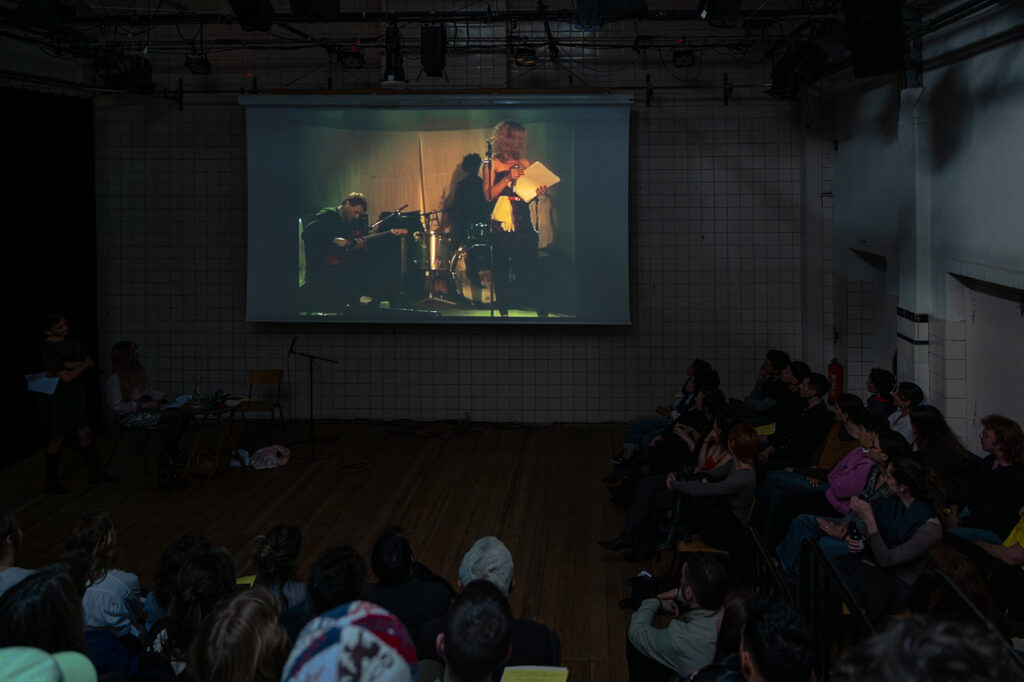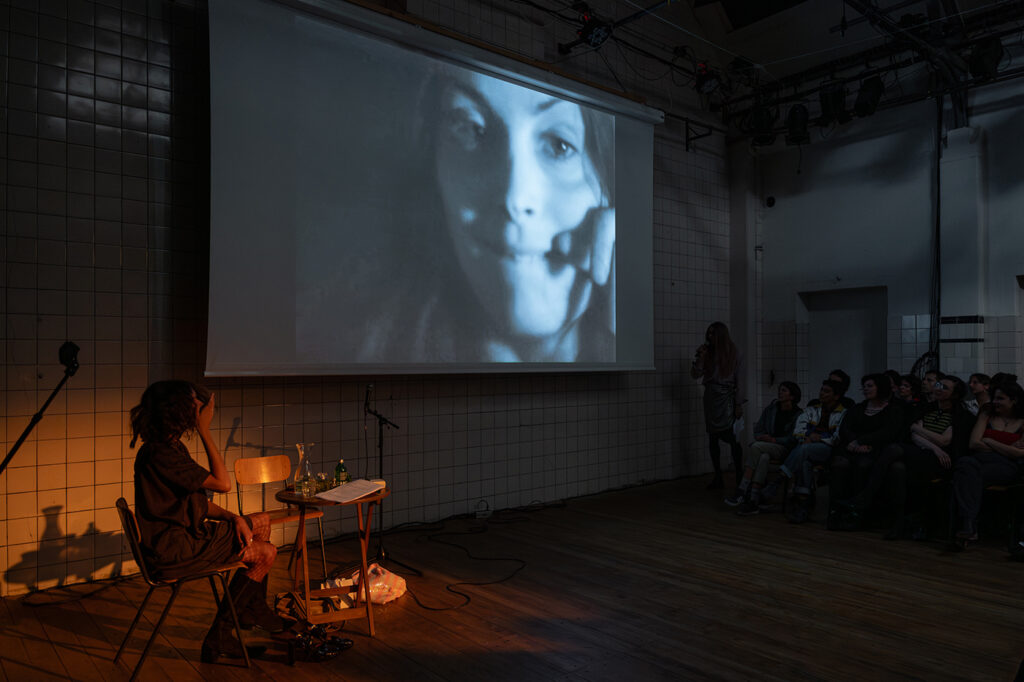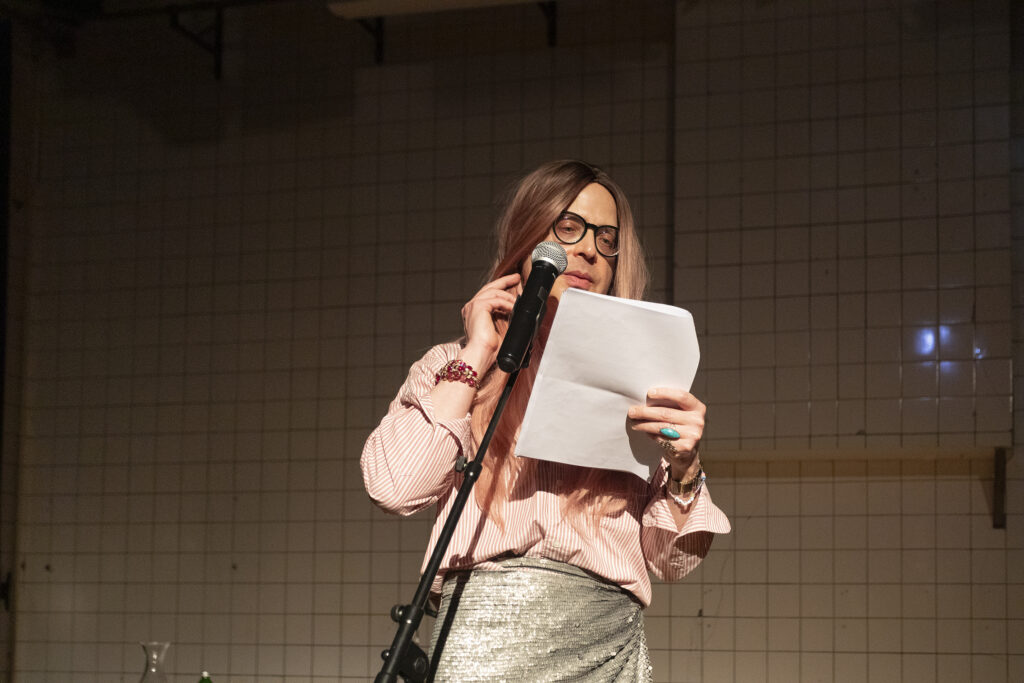An audience must be won over, one by one.
This edition of Prelude, titled One by One, combines moving image, live performance and performance documentation, and considers the question of how the body is seen, heard, defined and restricted. Dutch performance and video art pioneer Lydia Schouten enters into dialogue with artist Astrit Ismaili, who works in a similar spirit. Brussels-based Amina Szecsödy presents a performance and a spotlight is turned on the radical oeuvre of Hugo Roelandt. The artists’ future-oriented historical and recent works will converge this evening in an assemblage of live and projected images unfolding across time and space.
An audience must be won over, one by one.
Deze editie van Prelude, getiteld One by One, combineert videokunst, live performance en performanceregistraties en staat stil bij de vraag hoe het lichaam wordt gezien, gehoord, gedefinieerd en beperkt. De Nederlandse performance- en videokunst pionier Lydia Schouten treedt in dialoog met de in eenzelfde geest werkende Astrit Ismaili. Daarnaast is er een bijdrage van de in Brussel gevestigde Amina Szecsödy, en is er aandacht voor het radicale oeuvre van Hugo Roelandt. De toekomstgericht historische én recente werken van de kunstenaars komen deze avond samen in een assemblage van live en geprojecteerde beelden die zich door de tijd en ruimte heen zal ontvouwen.
(Read more)
Since the late 1970s, Lydia Schouten (*1948) has been uncompromisingly shaping her position as a woman and as a female artist. In her early performances, Schouten uses her own body, while her video works focus on varying characters in often alienating worlds. The media’s influence is a recurring motif.
Astrit Ismaili (*1991) uses body extensions, wearable instruments, alter egos and songwriting to explore the ‘transformative potential of body and space’, as well as new and unconventional forms of embodiment and representation. Early video works reveal a different side to the artist, who is known for their emotionally charged performances.
Themes such as beauty, lust and self-image, but also the desire for contact, are important to both artists. With unbounded imagination, Ismaili and Schouten create bold images and respond to imposed social and structural boundaries. During this Prelude evening, the artists will perform together.
Amina Szecsödy (*1995) is interested in historical views of the female body and voice as disruptors of power. She combines elements from the media, cinema and mythology, interweaving voices, images and stories from the past and future in the immediate present. Her performance Mean Time explores the relationship between present and future through the figure of a female oracle and reflects on the role of language and the power of words.
Finally, the work of Hugo Roelandt (*1950 – †2015) is highlighted in photographic images. Roelandt sought to deconstruct traditional notions of art. In the 1980s, he introduced “post-performance” as a system-oriented approach to the medium, independent of the artist’s body. Performers were replaced by machines and the emphasis shifted to the audience’s role in the experience of art. Art not as a solitary activity, but as a shared, participatory experience.
Roelandt’s working method thus connects with that of Prelude: experimenting with formats, defying conventions and with an emphasis on collective experience. Addressing themes of agency and autonomy, and through the interplay between artists and audience, this Prelude program once again invites you to experience and connect. You are most welcome.
Lydia Schouten (*1948) geeft vanaf eind jaren 1970 onverzettelijk haar positie als vrouw en als vrouwelijke kunstenaar vorm. In haar vroege performances zet Schouten haar eigen lichaam in, terwijl haar videowerken zich richten op uiteenlopende personages in vaak vervreemdende werelden. De invloed van de media is een terugkerend motief.
Astrit Ismaili (*1991) onderzoekt met lichaamsuitbreidingen, draagbare instrumenten, alter ego’s en songwriting het ‘transformatieve potentieel van lichaam en ruimte’ en welke nieuwe en onconventionele vormen van belichaming en representatie mogelijk zijn. Vroege videowerken laten een andere kant zien van de kunstenaar die bekend staat om emotioneel beladen performances.
Thema’s als schoonheid, lust en zelfbeeld, maar ook het verlangen naar contact, zijn belangrijk voor beide kunstenaars. Met onbegrensde verbeelding creëren Ismaili en Schouten uitgesproken beelden en reageren zij op opgelegde sociale en structurele grenzen. Tijdens deze Prelude avond voeren de kunstenaars samen een performance op.
Amina Szecsödy (*1995) is geïnteresseerd in historische opvattingen over het vrouwelijke lichaam en stem als verstoorders van macht. Ze combineert elementen uit de media, cinema en mythologie en vervlecht stemmen, beelden en verhalen uit verleden en toekomst in het directe heden. Haar performance Mean Time onderzoekt de relatie tussen heden en toekomst via de figuur van een vrouwelijke orakel en reflecteert op de rol van taal en de werking van woorden.
Tot slot komt het werk van Hugo Roelandt (*1950 – †2015) naar voren in fotografische beelden. Roelandt streefde ernaar traditionele opvattingen over kunst te deconstrueren. In de jaren 1980 introduceerde hij ‘post-performance’ als een systeemgerichte benadering van het medium, los van het lichaam van de kunstenaar. Performers werden vervangen door machines en de nadruk kwam te liggen op de rol van het publiek in de kunstervaring. Kunst niet als solitaire, maar als gedeelde, participatieve ervaring.
Roelandts werkwijze sluit hiermee aan bij die van Prelude: experimenteren met formats, tegen conventies in en met de nadruk op de collectieve ervaring. Via thema’s als zeggenschap en autonomie en door het samenspel van kunstenaars en publiek, nodigt dit Prelude programma wederom uit tot ervaren en verbinden. Wees welkom.
* ‘An audience must be won over, one by one’ is de titel van een schilderij van kunstenaar Sands Murray-Wassink, die deel uitmaakte van het openingsprogramma van Prelude


























